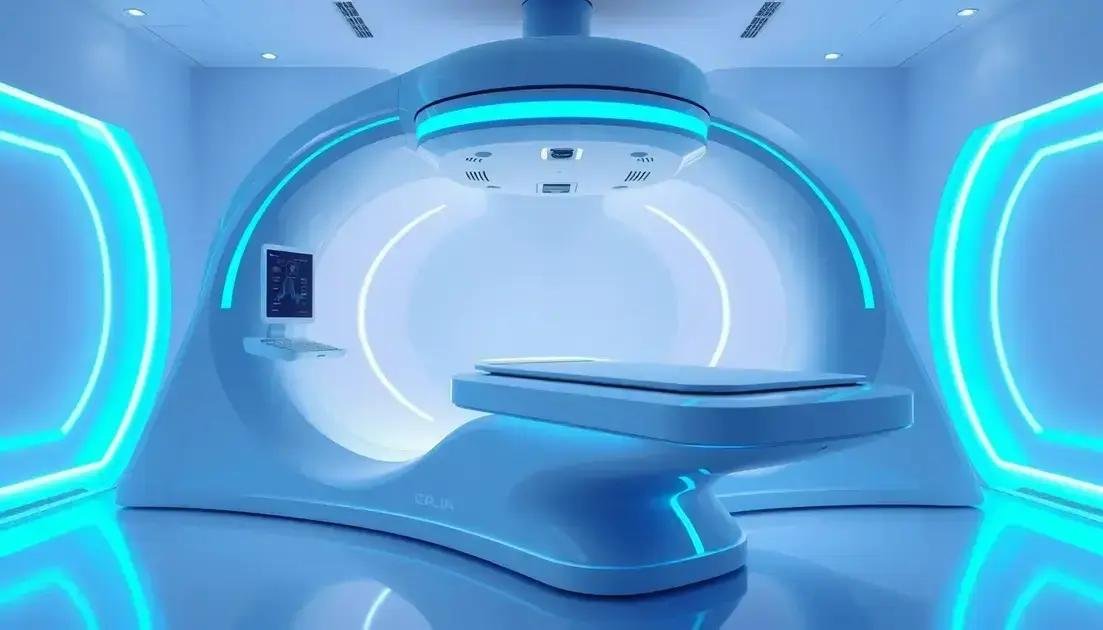
Revolutionizing Health: The Future of Prostate Cancer Treatment and Beauty
-
Maria Duarte
-
2, março, 2025
Topics
 Shared
Shared
In recent years, the field of prostate cancer treatment has seen substantial advancements.
These recent advances and future perspectives promise better outcomes for patients.
With a focus on innovative therapies and personalized medicine, the journey towards effective management continues.
Understanding Prostate Cancer
Understanding Prostate Cancer involves knowing the prostate’s role in the male reproductive system. It is a small gland that produces seminal fluid.
Prostate cancer arises when cells in the prostate grow uncontrollably, forming tumors. It may be localized or spread to other body parts. Risk factors include age, family history, and genetics.
Symptoms often include difficulty urinating, blood in urine, or pelvic discomfort. Regular screenings, such as PSA tests, can help in early detection.
Current Treatment Options

Current Treatment Options for prostate cancer depend on the cancer stage and patient health.
Common treatments include active surveillance, surgery, radiation therapy, hormone therapy, and chemotherapy.
Active surveillance is often used for slow-growing cancers and involves monitoring the cancer without immediate treatment.
Surgery can be performed to remove the prostate gland and surrounding tissue. This is known as a prostatectomy.
Radiation therapy uses high-energy rays to target and kill cancer cells. It can be external beam radiation or brachytherapy, where radioactive seeds are implanted in the prostate.
Hormone therapy reduces testosterone levels, which can help slow cancer growth.
Chemotherapy is typically reserved for advanced stages and involves using drugs to kill cancer cells.
Each treatment comes with potential side effects, and doctors work with patients to choose the best approach for their situation.
Innovative Drug Therapies
Innovative Drug Therapies are transforming the treatment landscape for prostate cancer. These therapies aim to target cancer cells more effectively while minimizing side effects.
One notable approach is targeted therapy, which focuses on specific genetic mutations within cancer cells. This allows for a more personalized treatment plan.
Advancements in Prostate Cancer Treatment
Another advancement is the use of anti-androgen drugs, which block the effects of testosterone and help slow the growth of cancer cells. Examples include enzalutamide and abiraterone.
Additionally, chemotherapy drugs have evolved, with newer agents offering enhanced efficacy and reduced toxicity. For instance, cabazitaxel is used for advanced cases to manage progression.
In clinical trials, immune-oncology agents are being investigated to help the body’s immune system recognize and destroy prostate cancer cells. These innovations are paving the way for future therapies.
Role of Immunotherapy

Role of Immunotherapy in prostate cancer treatment has emerged as a promising avenue. Immunotherapy works by enhancing the body’s immune system to identify and attack cancer cells more effectively.
One key form of immunotherapy is immune checkpoint inhibitors, which help remove the natural brakes on the immune system, allowing it to target cancer cells. These therapies aim to unleash the full potential of the immune response against tumors.
Therapeutic vaccines are another innovative approach. For example, sipuleucel-T is designed to stimulate the immune system specifically against prostate cancer cells. Chimeric antigen receptor (CAR) T-cell therapy is also being studied, where T-cells are modified to better attack cancer cells, leading to promising outcomes in trials.
Immunotherapy may also be combined with other treatments, enhancing overall effectiveness and providing new options for patients, especially those with advanced prostate cancer.
Advances in Radiotherapy
Advances in Radiotherapy for prostate cancer have revolutionized treatment options over recent years. Modern techniques are more precise, allowing for targeted delivery to cancerous tissues while minimizing damage to surrounding healthy cells.
One significant advancement is stereotactic body radiation therapy (SBRT). This method delivers high doses of radiation in fewer sessions, often improving convenience and outcomes for patients.
Another technique, called intensity-modulated radiation therapy (IMRT), adjusts the intensity of radiation beams according to the tumor’s shape and size. This customization leads to better control of the cancer and less exposure to nearby organs.
Additionally, image-guided radiation therapy (IGRT) enhances precision further by using imaging technology to position patients accurately before treatment, ensuring the tumor is targeted effectively.
These advances reflect a broader trend toward more effective and patient-friendly treatments, significantly improving quality of life for many prostate cancer patients.
Surgical Innovations

Surgical Innovations in prostate cancer treatment have significantly improved patient outcomes. These advancements focus on minimizing invasiveness and maximizing precision during procedures.
One of the most notable innovations is robot-assisted laparoscopic prostatectomy. This technique uses robotic systems to perform prostate surgery with enhanced accuracy, resulting in smaller incisions and faster recovery times.
Another important development is the use of nerve-sparing surgical techniques. These methods aim to preserve crucial nerves around the prostate, potentially reducing the risk of erectile dysfunction and incontinence.
Additionally, multimodal imaging technologies are being integrated into surgical planning. These technologies provide surgeons with detailed images of the prostate and surrounding areas, allowing for better decision-making during surgery.
These surgical innovations underscore a trend towards less invasive, more effective treatments that prioritize patient quality of life while addressing prostate cancer.
Genetic Research Breakthroughs
Genetic Research Breakthroughs in prostate cancer have paved the way for more effective personalized treatment strategies.
Researchers are focusing on identifying specific genetic markers that influence cancer behavior and response to therapies.
Recent studies have explored the role of genes such as BRCA1 and BRCA2. These genes are linked to increased prostate cancer risk and may inform treatment options, particularly with PARP inhibitors.
Additionally, advancements in next-generation sequencing (NGS) allow for comprehensive profiling of tumor DNA. This enables doctors to understand the unique genetic makeup of a patient’s cancer, tailoring therapies accordingly.
Understanding the genetic landscape of prostate cancer helps in predicting disease progression and potential treatment resistance, leading to better management strategies.
Overall, ongoing genetic research is crucial for developing targeted therapies and improving outcomes for patients with prostate cancer.
Personalized Medicine Approaches

Personalized Medicine Approaches are revolutionizing prostate cancer treatment by tailoring therapies to individual patients. This strategy takes into account the unique genetic makeup of each tumor, potential responses to treatments, and the patient’s overall health.
One important aspect is biomarker testing. By identifying specific biomarkers, doctors can predict how well a patient will respond to certain therapies, allowing for customized treatment plans.
Additionally, genomic profiling helps in understanding the mutations driving cancer growth. This information guides oncologists in selecting targeted therapies that are more likely to be effective.
Another promising development is liquid biopsies. These non-invasive tests analyze tumor DNA circulating in the blood, providing real-time insights into the disease and its progression.
Overall, personalized medicine approaches enhance treatment effectiveness and minimize unnecessary side effects, significantly improving the patient’s journey through prostate cancer.
Minimally Invasive Techniques
Minimally Invasive Techniques in prostate cancer treatment focus on reducing patient recovery time and minimizing surgical complications. These techniques often involve smaller incisions and less trauma to surrounding tissues.
One common method is laparoscopic surgery, where surgeons use small cameras and instruments to perform procedures through tiny incisions. This approach leads to reduced pain and faster healing.
An even more advanced option is robot-assisted laparoscopic surgery. Surgeons utilize robotic systems to enhance precision during the operation, improving outcomes while ensuring less blood loss.
Additionally, focal therapy is gaining traction. This technique targets only the tumor while sparing healthy tissue, which may result in fewer side effects.
Overall, minimally invasive techniques are reshaping the surgical landscape for prostate cancer, emphasizing patient safety and quality of life.
Managing Side Effects

Managing Side Effects of prostate cancer treatment is essential for improving patients’ quality of life. Various therapies can lead to side effects, and understanding them helps in finding effective management strategies.
Common side effects from treatments like surgery or radiation include fatigue, urinary issues, and sexual dysfunction. Open communication with healthcare providers can help in addressing these concerns.
To manage fatigue, a balanced diet, regular exercise, and sufficient rest are recommended. Urinary issues, such as incontinence, may be addressed through pelvic floor exercises and medications.
For sexual dysfunction, options like counseling, medications, and devices are available. Doctors can provide tailored solutions based on individual needs.
Support groups and counseling can also be invaluable. Connecting with others who are going through similar experiences can ease emotional burdens and provide valuable coping strategies.
Future Research Directions
Future Research Directions in prostate cancer aim to improve detection, treatment, and patient outcomes.
Ongoing studies focus on understanding the biological mechanisms of prostate cancer progression, which could lead to new therapeutic targets.
One promising area is precision medicine, which tailors treatment plans based on genetic and molecular profiling. This approach aims to increase the effectiveness of therapies while reducing side effects.
Additionally, research on novel drug combinations is underway. These combinations may enhance the efficacy of existing therapies and overcome resistance in advanced cases.
Clinical trials are crucial for testing new treatments. Many trials explore innovative approaches like immunotherapy and gene therapy, which harness the body’s immune system or make genetic modifications to combat cancer.
Finally, improving patient quality of life through supportive care strategies is a key focus. This includes better management of side effects and emotional support throughout treatment.
Patient Support and Resources

Patient Support and Resources are crucial for those diagnosed with prostate cancer. These resources provide information and emotional support, helping patients navigate their journey.
Support groups offer a safe space for patients and families to share experiences and coping strategies. Connecting with others facing similar challenges can reduce feelings of isolation.
Additionally, educational resources such as websites, brochures, and helplines provide valuable information about prostate cancer, treatment options, and side effect management.
Many hospitals and cancer centers also have nurse navigators who assist patients in understanding their diagnosis and treatment plans. They help coordinate care and answer questions.
Financial assistance programs may be available to help cover treatment costs and related expenses. Organizations like the American Cancer Society provide information about financial resources.
Overall, taking advantage of available support and resources can empower patients and improve their quality of life during treatment.
Conclusion
Recent advances in prostate cancer treatment showcase significant progress, from innovative drug therapies to personalized medicine. Understanding these developments empowers patients to make informed decisions about their care.
Ongoing research continues to enhance treatment options and improve patient outcomes, underscoring the importance of support and resources available throughout the journey.
FAQ – Understanding Prostate Cancer
What is prostate cancer?
Prostate cancer is a type of cancer that occurs in the prostate, a small gland that produces seminal fluid in men.
What are the main treatment options for prostate cancer?
Treatment options include active surveillance, surgery, radiation therapy, hormone therapy, and chemotherapy.
What are innovative drug therapies for prostate cancer?
Innovative drug therapies include targeted therapies, hormone therapies like enzalutamide, and new combinations of chemotherapy.
How does immunotherapy work for prostate cancer?
Immunotherapy enhances the body’s immune response to identify and attack prostate cancer cells more effectively.
What are the advances in radiotherapy for prostate cancer?
Recent advances include stereotactic body radiation therapy (SBRT) and intensity-modulated radiation therapy (IMRT), which improve precision.
What surgical innovations are available for prostate cancer?
Surgical innovations include robotic-assisted laparoscopic surgery and nerve-sparing techniques that minimize side effects.
What genetic research breakthroughs are relevant to prostate cancer?
Research focuses on identifying genetic mutations and biomarkers that inform treatment strategies and improve outcomes.
What are personalized medicine approaches in prostate cancer?
Personalized medicine tailors treatment based on a patient’s genetic makeup and tumor characteristics for better effectiveness.
How can side effects of prostate cancer treatments be managed?
Managing side effects includes lifestyle changes, medications, physical therapy, and psychological support.
What are the future research directions for prostate cancer?
Future research includes exploring precision medicine, new drug combinations, and supportive care strategies.
What patient support and resources are available?
Resources include support groups, educational materials, financial assistance programs, and counseling services.
 Return blog
Return blog